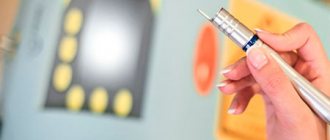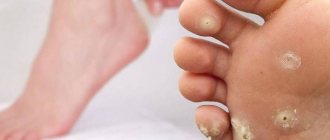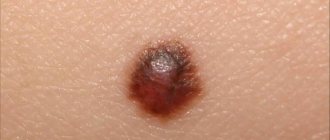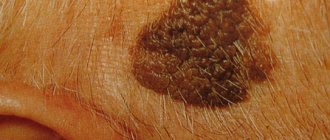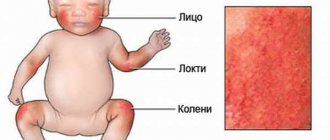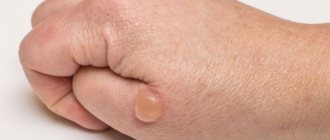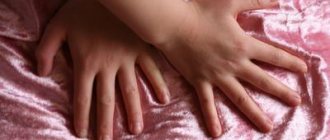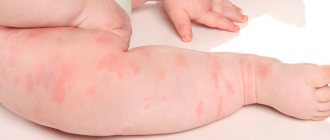Blisters on the ear: causes
Blisters are inflammations in the upper layer of the skin, which are characterized by clearly defined swelling, red or pinkish color, and the shape can be either blurry or clear.
Multiple vesicles - blisters, very similar to pimples, but with transparent contents, appear during an allergic skin reaction. But there are many more reasons when one or more blisters appear behind the ear:
- Insect bite: mosquito, midge, flea and others cause a slight swelling when bitten, which itches a lot
- Fungus: Fungal infections often cause a rash; if the infection occurs in the skin behind the ears, which is not uncommon, blisters and itching are likely.
- Miliaria: as on the fingers, in the armpits, behind the ears, where the skin often sweats under a warm hat, dyshidrosis can manifest itself.
- Friction: Sometimes a blister appears after intense rubbing of the skin behind the ear.
- Dermatitis: After contact with an irritating substance, contact dermatitis can appear behind the ear, where the skin is very delicate.
- Allergic reaction: hives after dyeing hair or changing shampoo or detergent appear and disappear within a few hours.
- Infection: chicken pox, measles, rubella and other infectious and highly contagious diseases occur with a rash in the form of blisters.
- Seborrhea: This disease can also affect the part of the scalp that is not covered with hair.
- Scrofula: many have not heard of this disease, meanwhile, grayish formations behind the ears, itchy and flaky - one of the most common diseases, it is caused by the tubercle bacillus, affects people (often children under 10 years of age, but sometimes adults), with a tendency to tuberculosis, weakened immune system.
- Neoplasms: often what a person mistakes for a blister does not go away for quite a long time; dense contents appear inside it, which keeps increasing, eventually forming not just a blister, but a huge “bump.” Such a blister may ultimately turn out to be either an epidermal cyst (benign tumor) or a malignant skin lesion.
- Otitis: inflammation can be both external and internal; itching and the appearance of a blister in the ear can also be the initial stage of otitis.
These and other reasons should force a person not to hesitate to contact a dermatologist, to follow his recommendations and advice regarding consultations with specialists - allergists, nutritionists, neurologists and venereologists.
Therapeutic measures
Therapy begins with the removal of tumors; most often, treatment with liquid nitrogen is carried out - cryodestruction. The growth freezes, blood supply and nutrition are stopped, as a result of which it dies. During the procedure, there may be a slight burning or tingling sensation.
Electrocoagulation - a high-frequency current passes through the electrode loop, which destroys the tumor. The manipulation is carried out under local anesthesia. After exposure, the treated area becomes covered with a crust. After a few days, the scab is sloughed off, revealing a healthy area of skin.
What to do if it itches, scratch it or endure it?
No scratching, no matter how itchy the skin affected by the blister. A serious risk of infection arises due to the specific location of the irritation.
Constant friction with hair and hats contributes to the introduction of harmful bacteria into micro-wounds; even a tiny scratch heals here very slowly, and dermatitis will have to be treated for at least a week.
When affected by a fungus or infectious disease, the risk of spreading the disease with the liquid contained in the blister increases significantly, so herpes, fungus, and lichen can be “spread” throughout the body.
First aid
One or more blisters that appear behind the ears should not be touched with bare hands, especially without treatment with an antiseptic.
If blisters appear where contact with a bandage, headdress or hair is inevitable, remove these squeezing and rubbing objects, put the hair in a ponytail, pin it up, comb it - do everything to avoid contact.
If you suspect an allergic reaction, remove substances that could cause it away: rinse off the hair dye immediately with plenty of water so that the blister does not develop into Quincke's edema (a life-threatening syndrome, which is essentially an ordinary but giant blister that causes suffocation), Wash off shampoos or gels with plenty of clean water.
- If there is a significant deterioration in health or shortness of breath, take the victim out into the fresh air, into a well-ventilated area.
- Give any antihistamine to relieve an exacerbation.
- Treat the surface behind the ears with an antiseptic.
- If severe itching occurs, apply ice; you can lubricate it with any remedy that relieves this symptom, from soda solution to Finalgon.
- If you feel unwell, call emergency medical help; if you feel well, go to the hospital to find out the cause of the blister.
Blister Treatment Options
If formations on the skin appear unexpectedly, and it is impossible to seek medical help, you need to remember about methods of help at home. You can alleviate the condition both with the help of medications and folk remedies.
Pharmaceutical ointments, plasters
- Having noticed a blister, treat the skin around it with an antiseptic;
- if the blisters are not damaged, carefully apply ointment with a cooling effect to a cotton pad, apply to the skin, and secure with a bandage;
- if the blisters burst, it is enough to lubricate them with anti-inflammatory ointment Solcoseryl, Methylurocil, oxolinic or tetracycline;
- repeat every 4 to 6 hours, carefully monitoring the patient’s condition.
For allergies and burns, you need to use products designed to treat them.
Treatment of blisters on the ear with traditional medicine
A lotion of soda with added water is applied to the affected area for insect bites to relieve itching.
Aloe juice, raw potatoes, carrots will help stop itching and inflammation.
A decoction of chamomile, sage, and birch buds will relieve inflammation and itching.
- Mix 1 tsp. dry herbs and buds.
- Boil 1 l. water, add raw materials.
- Boil over low heat for 3 minutes.
- Cool, moisten a disc or gauze in the broth, and apply to the affected area.
- Change every 2 – 3 hours.
This flock will help with burns, dermatitis, and allergic reactions.
Causes of blisters on and behind the ear
Blisters on the ears can be either independent formations on the skin or symptoms of serious diseases. The causes of blisters (single or multiple) can be:
- allergic reaction of the body;
- insect bites;
- burns (including sunburn);
- taking individually inappropriate medications or non-compliance with their dosage;
- failure to comply with personal hygiene rules;
- skin fungus;
- viral infection;
- inflammatory processes in the body.
Blisters from sunburn or insect bites are not particularly dangerous, except that in rare cases they can lead to skin infections.
Bubbles that appear as a result of infection with viruses or the formation of a focus of inflammation in the body carry a much greater danger and require special attention from the sick person.
If you know for sure that you could not be bitten by any insect or you have not eaten anything that could cause an allergy,
Diagnosis of papillomas
A dermatologist or otolaryngologist should diagnose papilloma in the ear. Having discovered a neoplasm during examination, he will consider how to treat the disease. There are many types of viruses, each of which has its own characteristics. PCR diagnostics of the DNA of the virus will allow it to be accurately determined. This type of research:
- will confirm that the causative agent of the pathology is the papilloma virus;
- determine its type;
- will determine the concentration of the virus in the body.
Information about the amount of viral material in the patient’s body is necessary to determine the approximate time of infection, identify persons with whom the patient has been in contact, for the purpose of examination and taking preventive therapeutic measures (if the virus poses a health hazard). PCR diagnostics also shows the status of the disease - whether it is chronic or in an acute form due to a sharp decrease in the body’s protective abilities. After analyzing the data obtained, the doctor can choose the optimal treatment.
If PCR diagnostics confirms the presence of the virus, then additional research is carried out. Since the main method of treating papillomas is removal, during surgery a biopsy of the material is performed for cytological examination. Histological examination of papillomas tissue gives more accurate results; the cells themselves and the structural features of the tissue are subject to examination. These tests provide accurate information about changes in the body and the possibility of malignancy.
How to treat if the appearance of a blister still cannot be avoided
Modern pharmaceuticals and traditional medicine recipes come to the aid of the sick.
Medicines to combat illness
Broad-spectrum antimicrobial ointments such as Tetracycline, Erythromycin, Levomekol ointment, the root cause of the appearance of a blister is unknown, because they act on almost any group of bacteria.
Furacilin solution will help disinfect the surface of the skin.
Treatment of blisters caused by the herpes virus
Antiviral ointments are used to treat blisters caused by the herpes virus. They act precisely, reach the source of inflammation faster, and many of them have healing properties.
The most commonly prescribed are Oxolinic ointment, Viferon, Zovirax, Cycloferon.
Treatment of blisters - signs of allergies
Help with blisters formed at the site of a burn
Panthenol foam cream has proven itself to be effective in the treatment of blisters from burns; it has a light texture that allows you to apply the product without increased friction of damaged skin.
The well-known balm Rescuer, made from natural ingredients, helps to accelerate the restoration of the protective properties of the burned area of the skin.
OzhogovNet and Appolo gels are also effective; they not only have antiseptic properties, but also have a wound-healing and analgesic effect.
How to properly care for your ears, watch this video:
Treatment of blisters - symptoms of fungal ear disease
To get rid of a blister formed due to ear fungus, you must first cure the fungus itself. If the fungus is caused by taking antibiotics or hormonal drugs, you should stop using them.
Vitamin therapy will help boost immunity, a decrease in which could also lead to the formation of ear fungus and, as a result, a blister.
Antifungal agents should be prescribed by an ENT specialist depending on the type of fungus (yeast-like, mold, especially pathogenic). Nitrofungin and Econazole are usually prescribed.
The very prescription of antibiotic drugs for internal use in the treatment of any ailment is strictly prohibited. Remember, only your doctor can prescribe antibiotics. By self-medicating, you can cause serious harm to your health.
Traditional medicine comes to the rescue
If you don’t want to poison your body with medications, you can turn to traditional medicine. There are many recipes to get rid of various types of blisters.
Chereda is a natural antihistamine
The series has excellent antibacterial and wound-healing properties. In addition, this plant has long been known as a natural antihistamine.
If you have allergies, you can also take the series orally. Brew 1 tablespoon of dried herb per glass of boiling water, leave for 20 minutes and drink warm. But this infusion should not be consumed more than 2-3 times a day.
Chamomile is an excellent anti-inflammatory agent
Truly a wonderful flower with a whole range of beneficial properties. Chamomile infusion has anti-inflammatory, antiviral and antimicrobial effects.
It is useful to use chamomile infusion lotions for blisters on the ears. This lotion will also relieve pain due to the soothing properties of chamomile. A crushed aloe vera leaf applied to the blister will have the same effect.
ICD-10
The human papillomavirus is included in the International Classification of Diseases, which describes diseases and other health problems in a form convenient for use throughout the world.
Once every 10 years, this document is revised and clarified; at the moment, the version from the 10th revision is used in healthcare.
According to ICD-10, warts are included in various classes of diseases; they can be found using the corresponding codes:
- simple warts – B07;
- anogenital warts – A63.0;
- laryngeal papillomas – D1;
- cervical papillomas – D0;
- papillomas of the bladder – 3.
Causes of ear herpes
The human body is a single balanced system. In case of weakening of the body as a whole or damage to its individual organs, the risk of pathogenic viruses entering the circulatory system increases.
The causes of herpes may be:
- Pregnancy. During pregnancy, a woman’s body is weakened due to the processes occurring in it. Weakened immunity opens the way for many pathogens.
- Prolonged hypothermia. This factor is the cause of many diseases, including herpes.
- Overheating in a bath or in the sun. Extreme temperatures disrupt the nervous and immune systems, which weakens the body.
- Nervous overload. Stress speeds up the heart rate and leads to improper metabolism.
- Menstruation, during which internal processes in the reproductive system change.
- Sexual contacts during which contraception is not used.
- Communication with a sick person.
- A previous viral disease that has weakened the immune system.
- Consumption of alcohol or drugs that interfere with the normal functioning of internal organs.
Through the skin or mucous membrane, the virus enters the circulatory system and spreads throughout the body. As soon as it hits the nerve endings, the first symptoms begin to appear.
Routes of infection
You can become infected with HPV through household contact, during sexual intercourse or at birth (the virus is transmitted from mother to child).
The viral warts shown in the photo are acquired through direct contact with an infected person or through household contact.
Warts are caused by a viral infection and, of course, can be infected.
This requires direct skin-to-skin contact or the use of personal hygiene items of an infected person.
According to statistics, the majority of the world's population is infected with this virus, the data speaks for itself.
Symptoms of the disease
As a rule, the first signs of the disease appear within a day after infection.
The symptoms of herpes are as follows:
- appearance of general malaise:
- fever and headache;
- sensation of noise and pressure in the ears;
- constant dizziness and lack of coordination;
- redness of the ears and edges of the nasal passage;
- the ear is very swollen;
- the appearance of small blisters on the ears, accompanied by itching;
- after 1-2 days, the bubbles on the ears open, yellowish liquid oozes from them;
- over time, the wounds heal and become covered with a brown crust, which disappears after 2-3 days;
- in case of complications, a rash also appears inside the ear canals, which is accompanied by severe pain that periodically occurs in different parts of the head;
- in especially severe cases, hearing is impaired.
However, with timely and proper treatment, complications can be easily avoided.
Localization of warts
Papilloma of the auricle has special differences from other warts. As soon as the wart appears on the ear, a red spot forms in the same place, after which a small wart begins to form on the surface of the skin.
Usually this happens unnoticed, because the appearance of papillomas is not accompanied by unpleasant symptoms.
After the formation of a small papule, a pineal growth begins to form with an uneven, round-shaped surface and a movable stalk.
Papilloma can form in the following places:
- Behind the ear;
- Behind the earlobe;
- Inside the ear (early canal area).
Photo
A wart on the ear forms in sizes from twenty to one hundred and twenty millimeters. The hue of such a neoplasm ranges from pale to deep red. Usually such growths are single, but when several small papillomas appear, they can grow together into one large wart and affect a large part of the parotid surface.
Methods of treating the disease
Treatment of the disease does not require surgery and is carried out exclusively with medication.
In all cases, you must consult a doctor who will prescribe the necessary medications and monitor and adjust the treatment process.
It is carried out in the following sequence:
- Since the disease is contagious, the patient should be isolated. It is advisable if he stays at home until complete recovery.
- Painkillers are taken. Depending on the severity of the lesion and the severity of the pain, analgesics are used in the form of injections, powders or tablets.
- Increased nutrition and consumption of foods and medications that strengthen the immune system are necessary. These are fresh fruits and vegetables, honey, cheese and milk (more details here).
- Antiviral drugs are prescribed. This may be Acyclovir, Valacyclovir, Famciclovir or Tromantadine.
- Medicines are used to restore normal activity of nerve endings and restore hearing.
- Various ointments are applied to the rash. These may be available drugs such as Zovirax and Gervirax. You need to constantly monitor your ear. A fresh coat of ointment should be applied immediately if it has been accidentally rubbed off or absorbed. You can replace ointments with castor or eucalyptus oil.
Acyclovir is an antiviral drug for the treatment of herpes.
You should not prescribe medications yourself. Many of them have serious side effects that can cause significant harm to the body.
The course of treatment must be continued until the rash on the ears completely disappears and the pain syndrome is eliminated.
The crusts formed at the site of the wounds cannot be torn off. They must fall off on their own. To reduce itching, you can moisten them with baby cream - this will make them softer and not bother you.
